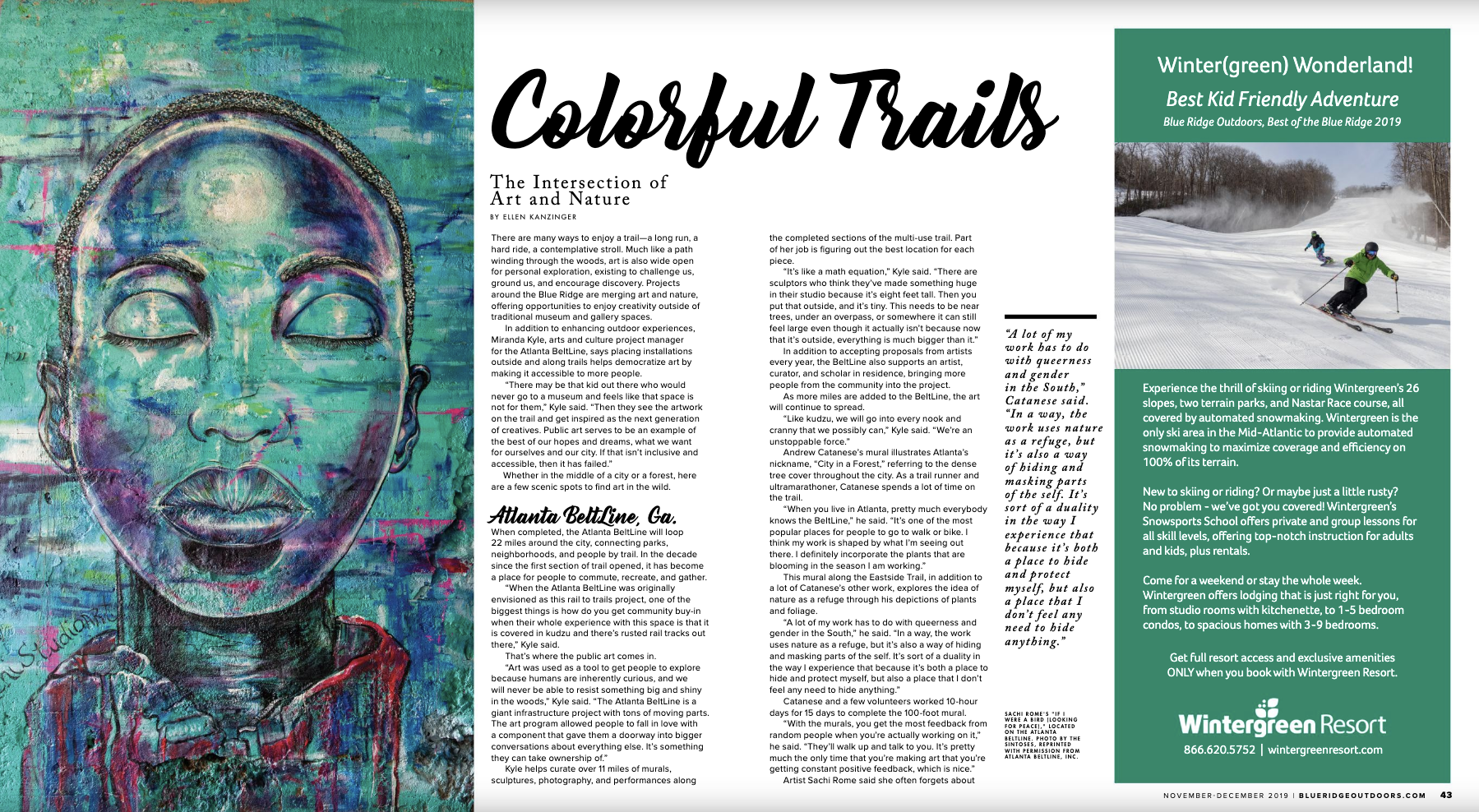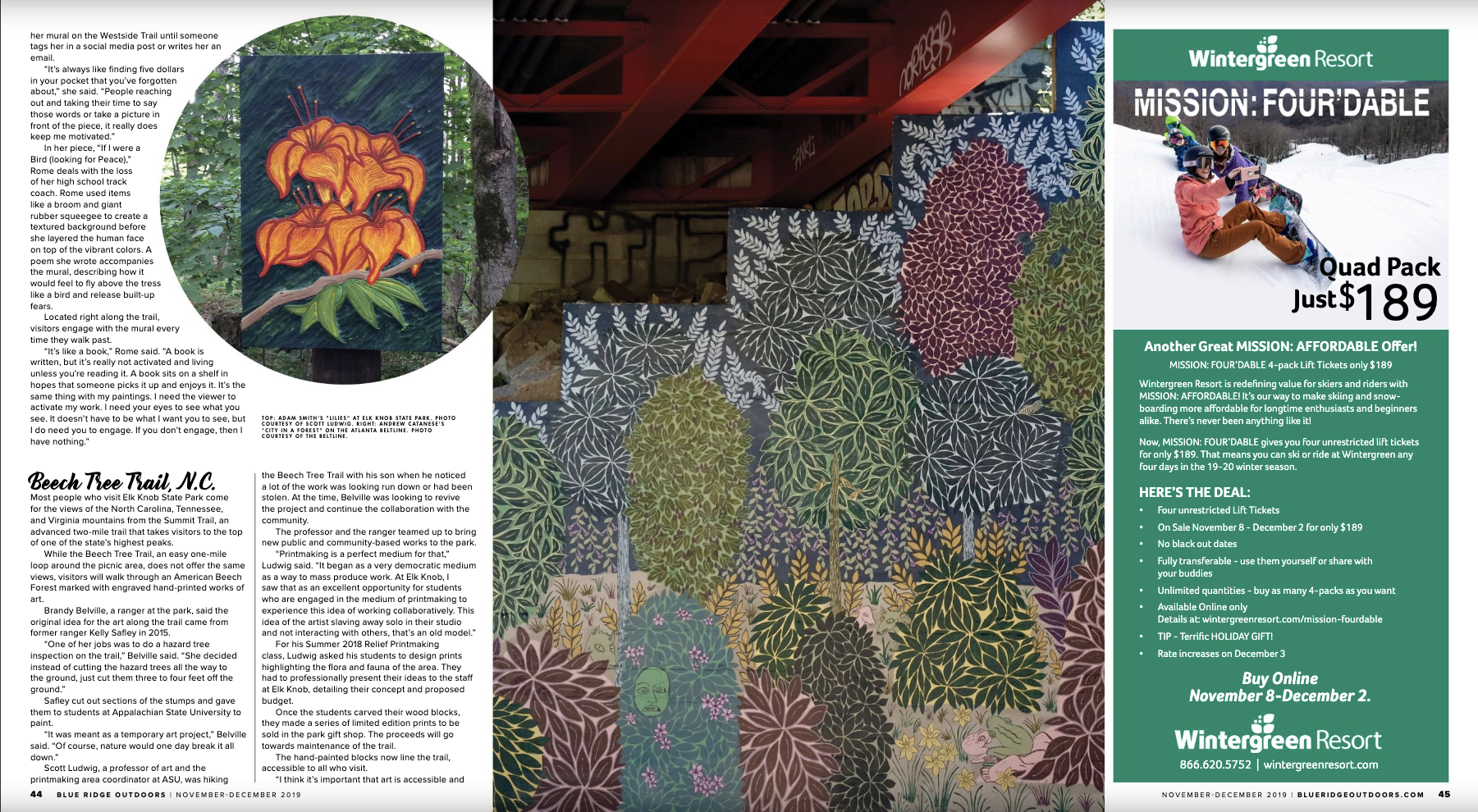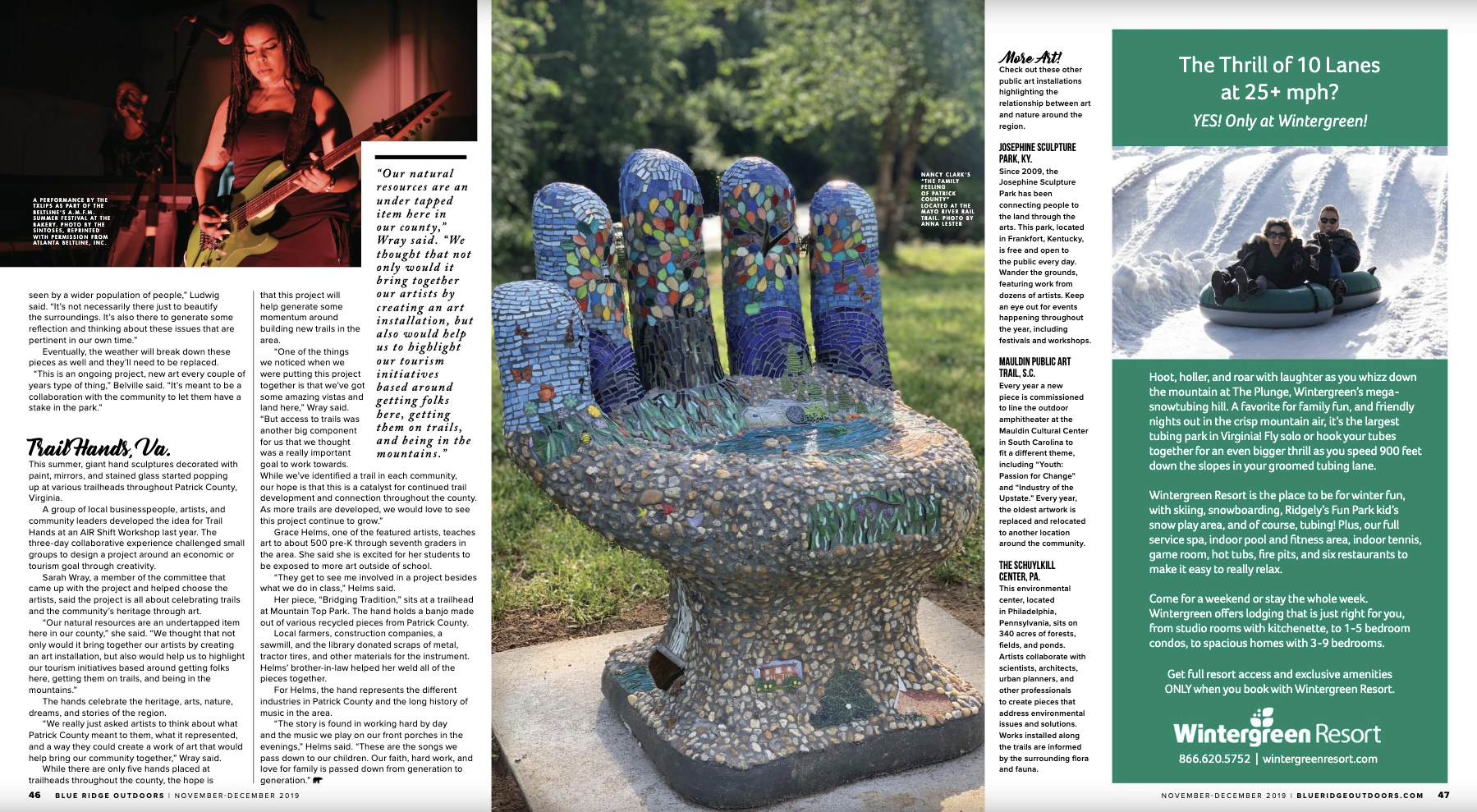Colorful Trails: The Intersection of Art and Nature
There are many ways to enjoy a trail—a long run, a hard ride, a contemplative stroll. Much like a path winding through the woods, art is also wide open for personal exploration, existing to challenge us, ground us, and encourage discovery. Projects around the Blue Ridge are merging art and nature, offering opportunities to enjoy creativity outside of traditional museum and gallery spaces.
In addition to enhancing outdoor experiences, Miranda Kyle, arts and culture project manager for the Atlanta BeltLine, says placing installations outside and along trails helps democratize art by making it accessible to more people.
“There may be that kid out there who would never go to a museum and feels like that space is not for them,” Kyle said. “Then they see the artwork on the trail and get inspired as the next generation of creatives. Public art serves to be an example of the best of our hopes and dreams, what we want for ourselves and our city. If that isn’t inclusive and accessible, then it has failed.”
Whether in the middle of a city or a forest, here are a few scenic spots to find art in the wild.
Atlanta BeltLine, Ga.
When completed, the Atlanta BeltLine will loop 22 miles around the city, connecting parks, neighborhoods, and people by trail. In the decade since the first section of trail opened, it has become a place for people to commute, recreate, and gather.
“When the Atlanta BeltLine was originally envisioned as this rail to trails project, one of the biggest things is how do you get community buy-in when their whole experience with this space is that it is covered in kudzu and there’s rusted rail tracks out there,” Kyle said.
That’s where the public art comes in.
“Art was used as a tool to get people to explore because humans are inherently curious, and we will never be able to resist something big and shiny in the woods,” Kyle said. “The Atlanta BeltLine is a giant infrastructure project with tons of moving parts. The art program allowed people to fall in love with a component that gave them a doorway into bigger conversations about everything else. It’s something they can take ownership of.”
Kyle helps curate over 11 miles of murals, sculptures, photography, and performances along the completed sections of the multi-use trail. Part of her job is figuring out the best location for each piece.
“It’s like a math equation,” Kyle said. “There are sculptors who think they’ve made something huge in their studio because it’s eight feet tall. Then you put that outside, and it’s tiny. This needs to be near trees, under an overpass, or somewhere it can still feel large even though it actually isn’t because now that it’s outside, everything is much bigger than it.”
In addition to accepting proposals from artists every year, the BeltLine also supports an artist, curator, and scholar in residence, bringing more people from the community into the project.
As more miles are added to the BeltLine, the art will continue to spread.
“Like kudzu, we will go into every nook and cranny that we possibly can,” Kyle said. “We’re an unstoppable force.”
Andrew Catanese’s mural illustrates Atlanta’s nickname, “City in a Forest,” referring to the dense tree cover throughout the city. As a trail runner and ultramarathoner, Catanese spends a lot of time on the trail.
“When you live in Atlanta, pretty much everybody knows the BeltLine,” he said. “It’s one of the most popular places for people to go to walk or bike. I think my work is shaped by what I’m seeing out there. I definitely incorporate the plants that are blooming in the season I am working.”
This mural along the Eastside Trail, in addition to a lot of Catanese’s other work, explores the idea of nature as a refuge through his depictions of plants and foliage.
“A lot of my work has to do with queerness and gender in the South. In a way, the work uses nature as a refuge, but it’s also a way of hiding and masking parts of the self. It’s sort of a duality in the way I experience that because it’s both a place to hide and protect myself, but also a place that I don’t feel any need to hide anything.”
Catanese and a few volunteers worked 10-hour days for 15 days to complete the 100-foot mural.
“With the murals, you get the most feedback from random people when you’re actually working on it,” he said. “They’ll walk up and talk to you. It’s pretty much the only time that you’re making art that you’re getting constant positive feedback, which is nice.”
Artist Sachi Rome said she often forgets about her mural on the Westside Trail until someone tags her in a social media post or writes her an email.
“It’s always like finding five dollars in your pocket that you’ve forgotten about,” she said. “People reaching out and taking their time to say those words or take a picture in front of the piece, it really does keep me motivated.”
In her piece, “If I were a Bird (looking for Peace),” Rome deals with the loss of her high school track coach. Rome used items like a broom and giant rubber squeegee to create a textured background before she layered the human face on top of the vibrant colors. A poem she wrote accompanies the mural, describing how it would feel to fly above the tress like a bird and release built-up fears.
Located right along the trail, visitors engage with the mural every time they walk past.
“It’s like a book,” Rome said. “A book is written, but it’s really not activated and living unless you’re reading it. A book sits on a shelf in hopes that someone picks it up and enjoys it. It’s the same thing with my paintings. I need the viewer to activate my work. I need your eyes to see what you see. It doesn’t have to be what I want you to see, but I do need you to engage. If you don’t engage, then I have nothing.”
Beech Tree Trail, N.C.
Most people who visit Elk Knob State Park come for the views of the North Carolina, Tennessee, and Virginia mountains from the Summit Trail, an advanced two-mile trail that takes visitors to the top of one of the state’s highest peaks.
While the Beech Tree Trail, an easy one-mile loop around the picnic area, does not offer the same views, visitors will walk through an American Beech Forest marked with engraved hand-printed works of art.
Brandy Belville, a ranger at the park, said the original idea for the art along the trail came from former ranger Kelly Safley in 2015.
“One of her jobs was to do a hazard tree inspection on the trail,” Belville said. “She decided instead of cutting the hazard trees all the way to the ground, just cut them three to four feet off the ground.”
Safley cut out sections of the stumps and gave them to students at Appalachian State University to paint.
“It was meant as a temporary art project,” Belville said. “Of course, nature would one day break it all down.”
Scott Ludwig, a professor of art and the printmaking area coordinator at ASU, was hiking the Beech Tree Trail with his son when he noticed a lot of the work was looking run down or had been stolen. At the time, Belville was looking to revive the project and continue the collaboration with the community.
The professor and the ranger teamed up to bring new public and community-based works to the park.
“Printmaking is a perfect medium for that,” Ludwig said. “It began as a very democratic medium as a way to mass produce work. At Elk Knob, I saw that as an excellent opportunity for students who are engaged in the medium of printmaking to experience this idea of working collaboratively. This idea of the artist slaving away solo in their studio and not interacting with others, that’s an old model.”
For his Summer 2018 Relief Printmaking class, Ludwig asked his students to design prints highlighting the flora and fauna of the area. They had to professionally present their ideas to the staff at Elk Knob, detailing their concept and proposed budget.
Once the students carved their wood blocks, they made a series of limited edition prints to be sold in the park gift shop. The proceeds will go towards maintenance of the trail.
The hand-painted blocks now line the trail, accessible to all who visit.
“I think it’s important that art is accessible and seen by a wider population of people,” Ludwig said. “It’s not necessarily there just to beautify the surroundings. It’s also there to generate some reflection and thinking about these issues that are pertinent in our own time.”
Eventually, the weather will break down these pieces as well and they’ll need to be replaced.
“This is an ongoing project, new art every couple of years type of thing,” Belville said. “It’s meant to be a collaboration with the community to let them have a stake in the park.”
Trail Hands, Va.
This summer, giant hand sculptures decorated with paint, mirrors, and stained glass started popping up at various trailheads throughout Patrick County, Virginia.
A group of local business people, artists, and community leaders developed the idea for Trail Hands at an AIR Shift Workshop last year. The three-day collaborative experience challenged small groups to design a project around an economic or tourism goal through creativity.
Sarah Wray, a member of the committee that came up with the project and helped choose the artists, said the project is all about celebrating trails and the community’s heritage through art.
“Our natural resources are an under-tapped item here in our county. We thought that not only would it bring together our artists by creating an art installation, but also would help us to highlight our tourism initiatives based around getting folks here, getting them on trails, and being in the mountains.”
The hands celebrate the heritage, arts, nature, dreams, and stories of the region.
“We really just asked artists to think about what Patrick County meant to them, what it represented, and a way they could create a work of art that would help bring our community together,” Wray said.
While there are only five hands placed at trailheads throughout the county, the hope is that this project will help generate some momentum around building new trails in the area.
“One of the things we noticed when we were putting this project together is that we’ve got some amazing vistas and land here,” Wray said. “But access to trails was another big component for us that we thought was a really important goal to work towards. While we’ve identified a trail in each community, our hope is that this is a catalyst for continued trail development and connection throughout the county. As more trails are developed, we would love to see this project continue to grow.”
Grace Helms, one of the featured artists, teaches art to about 500 pre-K through seventh graders in the area. She said she is excited for her students to be exposed to more art outside of school.
“They get to see me involved in a project besides what we do in class,” Helms said.
Her piece, “Bridging Tradition,” sits at a trailhead at Mountain Top Park. The hand holds a banjo made out of various recycled pieces from Patrick County.
Local farmers, construction companies, a sawmill, and the library donated scraps of metal, tractor tires, and other materials for the instrument. Helms’ brother-in-law helped her weld all of the pieces together.
For Helms, the hand represents the different industries in Patrick County and the long history of music in the area.
“The story is found in working hard by day and the music we play on our front porches in the evenings,” Helms said. “These are the songs we pass down to our children. Our faith, hard work, and love for family is passed down from generation to generation.”
This article originally appeared in Blue Ridge Outdoors Magazine’s November/December 2019 issue.


